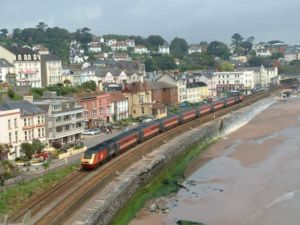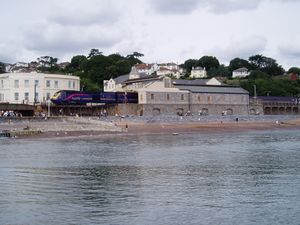Riviera Line
| Exeter-Paignton "Riviera" Line |
|
|
The Riviera Line is a local railway line in the English county of Devon that connects the city of Exeter to the "English Riviera" resorts of Torquay and Paignton.
The towns and villages served by the route are listed below. The route follows the Great Western Main Line between Exeter and Newton Abbot before diverging to the south-east.
Local passenger services are operated by First Great Western. Paignton is also served by First Great Western express services, Virgin Trains and South West Trains, which all operate longer-distance services to London or the Midlands. In the summer months, additional services are operated to cater for holidaymakers.
Contents
History
The line from Exeter was opened by the South Devon Railway on 30 May 1846 and was extended to Newton Abbot on 30 December 1846. After the company had completed its main line to Plymouth it opened a branch from Newton Abbot to Torquay on 18 December 1848. After many years this was extended as the independent Dartmouth and Torbay Railway to Paignton on 2 August 1859.
These lines were built as single-track, 7 feet ¼ inch broad gauge railways by Isambard Kingdom Brunel. They were designed to be worked with atmospheric power, but this was only used from 13 September 1847 until 9 September 1848 although the remains of several of the stationary engines can still be seen by the side of the line. The track was converted to standard gauge on May 21 1892. Double track was laid in sections over many years, the work needing the widening or removal of several tunnels near Dawlish.
The Torquay and Dartmouth Railway was operated from the outset by the South Devon Railway and amalgamated with it in 1872. This company in turn amalgamated with the Great Western Railway on 1 February 1876 which lasted until 31 December 1947 after which it was nationalised as part of British Railways.
Route description
Exeter to Dawlish Warren
After leaving Exeter St Davids, the line crosses the River Exe and passes above the suburbs of Exeter along a stone viaduct on which is situated Exeter St Thomas railway station. Beyond this is an industrial area where two lines used to branch out. On the left a short line went down to the Exeter Canal at City Basin; on the right a longer branch ran to Heathfield railway station on the Newton Abbot to Moretonhampstead branch.
Once out in the countryside it crosses marshes and passes the site of Exminster railway station. The canal comes into view on the left and joins the River Exe, as does the railway, at Turf. The square pond next to the line is the site of Turf engine house. This stretch of the line used to have long water troughs between the rails from which steam locomotives could refill their water tanks without stopping.
From Powderham Castle the railway is right alongside the river; on one side of the line is the castle's deer park, while on the other, across the river, trains on the Avocet Line may be seen near Lympstone Commando railway station. Our train now enters the village of Starcross; beyond Starcross railway station is the pier for the ferry to Exmouth and the old Starcross engine house.
A little further along the river the railway crosses the mouth of Cockwood harbour. Near the shipwreck here was the 1,285 feet long Exe Bight Pier, in use from 1869 for about ten years. Dawlish Warren now comes into sight, the sand dunes are home to a nature reserve where many wading and sea birds can be seen. The railway line opens out into four lines at Dawlish Warren railway station, where the platforms are alongside loop lines that allow fast trains to overtake stopping services.
Dawlish Warren to Newton Abbot
After passing the seaside amusements of Dawlish Warren the railway comes onto the Sea Wall which it shares with a footpath, although it quickly enters the short and deep cutting at Langstone Rock. Emerging above the beach, views can be had across the sea towards Torbay.
Approaching Dawlish railway station Coastguard's Cottage is on the right (landward side). Although now a cafe, this building was used by the railway during its construction and then sold to the coastguard. Their boat house is below the footbridge. The town can be seen off to the right from Colonnade Viaduct at the other end of the station.
The line now enters its first tunnel, Kennaway, beneath Lea Mount, beyond which is Coryton beach and the Coryton tunnel. The next beach is the private Shell Cove and then the railway passes through Phillot Tunnel and Clerk's Tunnel, emerging onto a section of sea wall at Breeches Rock before diving into Parson's Tunnel beneath Hole Head. The last two tunnels are named after the Parson and Clerk Rocks, two stacks in the sea off Hole Head.
Beyond Parson's Tunnel is a short viaduct across Smugglers Lane and then the footpath resumes alongside the line for the final stretch of the Sea Wall past Sprey Point to the cutting at Teignmouth Eastcliff. On the landward side of the railway near Sprey Point can be seen the remains of a lime kiln used during the construction of the line.
The railway passes through Teignmouth railway station then continues through a cutting to emerge behind the busy Teignmouth Harbour, after which the railway resumes its course alongside the water, the River Teign. The cuttings on both sides of the station were originally tunnels and were opened out between 1879 and 1884. The railway passes under the Shaldon Bridge and then follows the river past the small promontories at Flow Point, Red Rock, and Summer House, opposite which can be seen the waterside inn at Coombe Cellars.
After leaving the riverside the line crosses Hackney Marshes and passes between the railway sidings at Hackney Yard and the race course to reach Newton Abbot railway station. The industrial area to the left of the station (when going in this direction) is the site of the South Devon Railway locomotive workshops - the older stone buildings dating from this time.
Newton Abbot to Paignton
Leaving Newton Abbot the railway widens out to four tracks; the two for Totnes diverge to the right at Aller Junction while the Riviera Line trains climb and then slowly descend towards the sea at Torquay. First though, they pass through Kingskerswell where there used to be a station.
Just before Torre railway station the line curves through a cutting; the Torquay engine house still stands on the top of the cutting on the right. On the left a stone building is the old goods shed while sidings for coal traffic were situated on the opposite side of the line. The green, wooden building alongside the track is the original South Devon Railway terminus, the current platforms dating from 1859 when the line was extended. The station was also renamed then, having been known as "Torquay" until then. The disused signal box on the eastbound platform was unusually tall to allow the signalman to look over the footbridge to see trains approaching up the steep gradient.
Our train now drops down this to reach the newer Torquay railway station opened in 1859, although today's large stone buildings and old signal box date from 1878. Unlike the original station, this Torquay station is right by the beach at Abbey Sands and a level promenade links it with the harbour and town centre.
On leaving the station the line passes beneath an ornamental cast iron bridge, through a small cutting, and then climbs alongside Livermead Beach to pass a headland at Preston before dropping down again into Paignton with more views of the beaches and sea. Immediately outside Paignton railway station is a busy level crossing right in the town centre. The ticket office is now situated in the 1859 goods shed; the bus station is right outside the front door while the Paignton and Dartmouth Steam Railway is situated alongside on the other side of the station.
The railway line continues beyond the station to reach carriage sidings at Goodrington Sands and to provide a connection that allows special trains to run through to Kingswear over the steam railway.
References
- Beck, Keith (1990). The Great Western in South Devon. Didcot: Wild Swan Publication. ISBN 0-906867-90-8.
- Gregory, R H (1982). The South Devon Railway. Salisbury: Oakwood Press. ISBN 0-85361-286-2.
- Kay, Peter (1991). Exeter - Newton Abbot: A Railway History. Sheffield: Platform 5 Publishing. ISBN 1-872524-42-7.
- Potts, C R (1998). The Newton Abbot to Kingswear Railway (1844 - 1988). Oxford: Oakwood Press. ISBN 0-85361-387-7.



